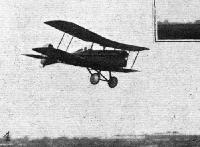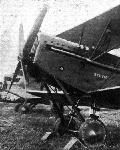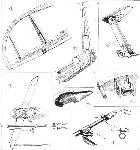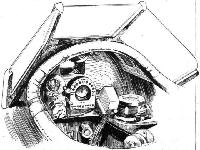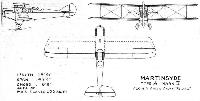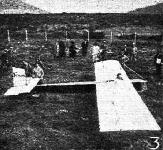Фотографии
-
PROM THE AERIAL DERBY: Flight-Lieut. Longton crossing the line on one of the A.D.C. S.E.5a's.
Самолёты на фотографии: RAF S.E.5 - Великобритания - 1916
-
A VICKERS VIKING IN JAVA: Gradually the uses of amphibian seaplanes increase as the advantages are realised. Recently Vickers sent one of the Vikings (Napier Lion) out to Java, where it has caused the greatest interest. Our photograph shows the machine surrounded by the mechanics who erected it. Needless to say, the civil population took the opportunity afforded of inspecting one of the latest types of aircraft, and, the admiration was general.
Самолёты на фотографии: Vickers Viking / Type 54 - Великобритания - 1919
-
Регистрационный номер: G-EAVP THE AERIAL DERBY: The Bristol Monoplane, 100 h.p. Bristol "Lucifer."
Самолёты на фотографии: Bristol M.1A / M.1B / M.1C - Великобритания - 1916
-
THE AERIAL DERBY: Martinsyde F.4, 300 h.p. Hispano-Suiza.
Самолёты на фотографии: Martinsyde F.3 / F.4 Buzzard - Великобритания - 1918
-
Регистрационный номер: G-EAUM PROM THE AERIAL DERBY: Bert Hinkler gets away on the Avro Baby.
Самолёты на фотографии: Avro Baby / Type 534 - Великобритания - 1919
-
Регистрационный номер: G-EBDA London-Moscow in an Avro Baby, 35 h.p. Green engine: A few weeks ago a very remarkable flight was made from London to Moscow in an Avro Baby. The pilot, a Russian named Gwailer, is seen in the photograph, which was taken just before the start of the flight. The machine was held up for some considerable time in Germany, the strange combination of a Russian pilot in a British machine, alighting on German soil, leading to complications. However, all difficulties were smoothed out ultimately, and the machine reached its goal in safety.
Самолёты на фотографии: Avro Baby / Type 534 - Великобритания - 1919
-
THE BRITISH SEAPLANE VICTORY: Matched against the fastest seaplanes in the world, the Supermarine, with Napier Lion engine, piloted by Mr. Biard, has beaten its competitors, and won this year's Schneider race at Naples. As a result, next year's race will be flown in this country. Our photographs show the hull of the Supermarine flying boat and the Napier Lion ready for installation at the Supermarine works, Southampton, and, on the left, the complete machine on the slipways. Inset is a portrait of Mr. Biard, chief pilot of the Supermarine Aviation Works.
Самолёты на фотографии: Supermarine Sea Lion / Sea King - Великобритания - 1919
-
FOR THE SCHNEIDER CUP: Swinging the Napier Lion-engined Supermarine Flying Boat on to the S.S. "Philomel" at Southampton for transhipment to Naples. In the group are Capt. H. J . Field, Mr. Scott-Paine and Mr. Braid. The date for the Schneider Cup was advanced by two weeks, and it was only by the sportsmanlike action of the General Steam Navigation Company in diverting the "Philomel'' to Southampton from her normal course to Naples that the Supermarine boat will be enabled to make a bid at Naples to bring back the Cup to England,
Самолёты на фотографии: Supermarine Sea Lion / Sea King - Великобритания - 1919
-
Регистрационный номер: G-EBDO [4] THE D.H.37: Rear view.
Самолёты на фотографии: De Havilland D.H.37 - Великобритания - 1922
-
Регистрационный номер: G-EBDO [4] THE D.H.37: Front view.
Самолёты на фотографии: De Havilland D.H.37 - Великобритания - 1922
-
Регистрационный номер: G-EBDO [4] The D.H.37, with 275 h.p. Rolls-Royce "Falcon" engine.
Самолёты на фотографии: De Havilland D.H.37 - Великобритания - 1922
-
Регистрационный номер: G-EBDO [4] View of engine housing and undercarriage of D.H. 37.
Самолёты на фотографии: De Havilland D.H.37 - Великобритания - 1922
-
The D.H.37: Diagrammatic perspective sketch of the aileron and elevator controls. All controls work in ball bearings.
Самолёты на фотографии: De Havilland D.H.37 - Великобритания - 1922
-
THE DE HAVILLAND 37: Some radiator details. A and B, details of the shutter, C, the trunnion mounting which supports the radiator.
Самолёты на фотографии: De Havilland D.H.37 - Великобритания - 1922
-
THE D.H.37: Some constructional details. 1, General construction of an aileron. Note the laminated corner. 2 Detail of aileron, showing how spar is stiffened against torsion by horizontal U of thin three-ply. 3, The very substantial tail skid, for which large bearing area is provided. Note detachable metal shoe. 4, Elevator crank lever with its ball bearing. The horizontal rod below is incorporated in the rudder control cable. 5, is the aluminium streamline casing which covers the elevator ball bearing. 6, Details of the lower plane spar root which is carried in a fitting on the side of the fuselage. 7, Details of the adjustable pedal on the foot bar.
Самолёты на фотографии: De Havilland D.H.37 - Великобритания - 1922
-
D.H.37 275 hp Rolls Royce "Falcon" Engine
Самолёты на фотографии: De Havilland D.H.37 - Великобритания - 1922
-
The Dornier "Dragon-fly" Flying Boat, with which experiments were carried out some time ago on Lake Constance (Switzerland), in alighting on and taking off from the ice.
Самолёты на фотографии: Dornier Do.A Libelle / Spatz - Германия - 1921
-
FROM THE FRENCH GLIDING COMPETITION AT CLERMONT-FERRAND: Bossoutrot soaring out over the Camp Mouillard on the Farman Sport biplane. This machine has to its credit the greatest aggregate duration of the meeting.
Самолёты на фотографии: Farman David / Sport - Франция - 1919
-
Гигантский для своего времени экспериментальный ночной бомбардировщик фирмы "Farman" обладал мощным шасси и развитой системой стоек. Военных устраивала большая масса полезной нагрузки, но самолет был слишком большим и сложным - в гражданском секторе рынка заказчиков на него не нашлось.
THE FARMAN FOUR-ENGINED NIGHT BOMBER: At the last Paris Aero Show one of the machines exhibited on the Farman stand was a large four-engined night bomber, the B.N.4, with four Lorraine-Dietrich engines of 400 h.p. each. This machine has now been flown, M. Bossoutrot taking it into the air on August 1, before the "Section Technique." The B.N.4 weighs, with full load, about ten tons, and carries fuel for a flight of seven hours' duration. In addition it is armed with machine guns for repulsing attack, and carries a long-range wireless outfit, so as to be always in communication with its base.Самолёты на фотографии: Farman BN.4 - Франция - 1921
-
Регистрационный номер: G-EAXZ [2] THE photograph shows aeroplanes lined up for the start of the Aerial Derby in 1922. In front may be seen the Gloster Bamel.
Самолёты на фотографии: Gloster Mars (Bamel) / Nighthawk / Sparrowhawk - Великобритания - 1921
-
Регистрационный номер: G-EAXZ [2] PROM THE AERIAL DERBY: J. H. James leaving on the Gloucestershire Aircraft Co. Mars I.
Самолёты на фотографии: Gloster Mars (Bamel) / Nighthawk / Sparrowhawk - Великобритания - 1921
-
THE AERIAL DERBY: Mars III, 200 h.p. B.R.2.
Самолёты на фотографии: Gloster Mars (Bamel) / Nighthawk / Sparrowhawk - Великобритания - 1921
-
All that happened: When, on alighting after winning the Derby, Mr. James was in danger of running into a crowd of people (who ought not to have been there), he effected a masterly "save" by swerving to the right. His left tyre, as a consequence, came off, but otherwise nothing happened.
Самолёты на фотографии: Gloster Mars (Bamel) / Nighthawk / Sparrowhawk - Великобритания - 1921
-
Регистрационный номер: G-EATS THE AERIAL DERBY: Bristol "Bullet," 400 h.p. Bristol "Jupiter."
Самолёты на фотографии: Bristol Bullet - Великобритания - 1919
-
FROM THE FRENCH GLIDING COMPETITION AT CLERMONT-FERRAND: Sardier on the Clement triplane in flight.
Самолёты на фотографии: Clement (Louis) triplane - Франция - 1919
-
THE MARTINSYDE TYPE A, MARK II: Three-quarter front view.
Самолёты на фотографии: Martinsyde F.4A / F.6 / A - Великобритания - 1919
-
THE MARTINSYDE TYPE A, MARK II: On the left the engine housing, and on the right the cabin, pilot's cockpit, etc. The front compartment contains the wireless set. The pipe which can be seen inside this compartment is a hot air pipe from the engine housing, carrying heated air to the cabin.
Самолёты на фотографии: Martinsyde F.4A / F.6 / A - Великобритания - 1919
-
Регистрационный номер: G-EBDK PROM THE AERIAL DERBY: F. P. Raynham taking off on his Martinsyde F.6.
Самолёты на фотографии: Martinsyde F.4A / F.6 / A - Великобритания - 1919
-
THE AERIAL DERBY: Martinsyde F.6, 180 h.p. Wolseley "Viper."
Самолёты на фотографии: Martinsyde F.4A / F.6 / A - Великобритания - 1919
-
The Martinsyde Type A, Mark II: Diagrammatic perspective view of the cabin, which has seating accommodation for four passengers. The deck fairing in front of the forward compartment contains the wireless outfit, and in the floor of the compartment is a mounting for an aerial camera. The hinged cabin roof is covered with gauze to ensure ventilation.
Самолёты на фотографии: Martinsyde F.4A / F.6 / A - Великобритания - 1919
-
The Martinsyde Type A, Mark II: Sketch of the pilot's cockpit, showing instrument board. In the centre of the board may be seen the tell-tale lights of the Vickers-Reid gyro turn indicator.
Самолёты на фотографии: Martinsyde F.4A / F.6 / A - Великобритания - 1919
-
Martinsyde Type A Mark II 275 h.p. Rolls-Royce "Falcon"
Самолёты на фотографии: Martinsyde F.4A / F.6 / A - Великобритания - 1919
-
Hannover Glider 1921 Type
Самолёты на фотографии: Hannover H.1 Vampyr / H.2 Greif / Strolch - Германия - 1921
-
Регистрационный номер: G-EAAC THE DE HAVILLAND AEROPLANE HIRE SERVICE: Line-up of the ten machines which at present constitute the "stable."
Самолёты на фотографии: De Havilland D.H.9B / D.H.9C - Великобритания - 1919
-
FROM THE FRENCH GLIDING COMPETITION AT CLERMONT-FERRAND: Chardon, the Swiss representative, starting off by running down the hill.
Самолёты на фотографии: Chardon glider - Швейцария - 1922
-
FROM THE FRENCH GLIDING COMPETITION AT CLERMONT-FERRAND: The Farman "Moustique" on which Bossoutrot has made some excellent flights.
Самолёты на фотографии: Farman Moustique - Франция - 1919
-
FROM THE FRENCH GLIDING COMPETITION AT CLERMONT-FERRAND: Coupet well aloft on his cantilever monoplane glider.
Самолёты на фотографии: Coupet-Guerchais glider - Франция - 1922
-
The New Hanriot All-Metal Two-Seater Fighter.
Самолёты на фотографии: Hanriot HD.15 - Франция - 1922
-
THE HANRIOT TYPE H.15: Some constructional details. In the drawing on the left, 1 and 2 are the top longerons of the fuselage; 3 and 4, centre-section struts; 5 and 6, sloping struts to lower plane; 7, horizontal strut in top of fuselage. In the right-hand sketch, 1 is the Duralumin box spar; 2, wooden end piece of spar; 3, front auxiliary spar; 4, rear auxiliary spar; 5, aileron spar; 6, tubular leading edge; 7, rib flange (tubular); 8, rib trellis; 9, gusset plate, securing ribs to spar; 10, aileron rib; 11, aileron crank; 12, tubular wing tip.
Самолёты на фотографии: Hanriot HD.15 - Франция - 1922
-
THE IRWIN "METEORPLANE" (MODEL M.T.): An American sporting biplane of 15 h.p. On the left its constructor, J. F. Irwin, is shown standing beside the machine, giving an idea as to its size. Inset (right), the machine in flight.
Самолёты на фотографии: Irwin M-T Meteorplane - США - 1919
Статьи
- Flight
